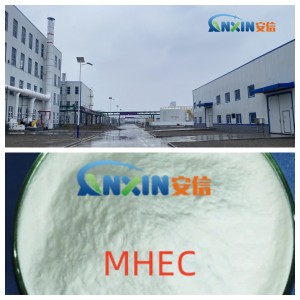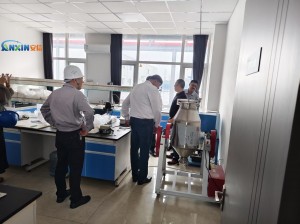Methyl Hydroxyethyl Cellulose (MHEC) is a commonly used nonionic cellulose ether widely used in construction chemicals. It exhibits excellent thickening, water retention, film-forming, bonding, and dispersing properties, making it an essential additive in dry-mix mortars, tile adhesives, putty powders, gypsum-based materials, and coating systems.
1. Thickening and Rheology Control
In cement mortar and gypsum-based products, MHEC thickens by forming hydrogen bonds with water molecules, increasing the viscosity of the solution. This property effectively improves the fluidity and workability of the slurry, preventing segregation or bleeding during mixing and application. In tile adhesives and putty powders, the addition of MHEC makes the materials easier to apply, creates a more uniform surface, and improves construction efficiency.
2. Water Retention and Delayed Drying
One of MHEC’s most notable properties is its excellent water retention. During the construction of cement mortar and gypsum products, rapid evaporation of water can easily lead to insufficient strength, cracking, or decreased adhesion. MHEC forms a uniform molecular film within the system, slowing water evaporation and ensuring full hydration of cement and complete hardening of gypsum, thereby enhancing the material’s ultimate strength and durability. This property is particularly important in hot, dry construction environments.
3. Improved Workability
MHEC significantly improves the workability of construction chemicals. It enhances the lubricity of mortar, making it smoother during scraping and troweling, reducing construction resistance and labor intensity. Furthermore, due to its thixotropic properties, MHEC maintains a high viscosity when static during construction, preventing sagging or dripping. When subjected to external forces, its viscosity decreases, facilitating application and spreading. This rheological adjustment significantly enhances the construction experience.
4. Improved Bond Strength
In tile adhesives, exterior wall insulation systems, and self-leveling mortars, MHEC improves the mortar’s water retention and wettability, enhancing its adhesion to both the base and facing materials. Adding MHEC to tile adhesive ensures sufficient open time for tiles during installation, preventing hollowing or falling due to rapid water loss. Furthermore, the uniform hydration reaction within the mortar significantly enhances bond strength, ensuring the structural integrity and safety of the building.
5. Improving Weatherability and Surface Quality
MHEC helps form a uniform and dense surface structure in mortar and paint systems, effectively reducing the likelihood of cracks. In putty powder and exterior wall coatings, MHEC enhances film-forming properties and smoothness, resulting in a smooth and fine wall surface and providing an excellent base for subsequent coatings. Furthermore, it improves the freeze-thaw resistance and weather resistance of the system, ensuring stable performance in various climates.
6. Application Examples
Tile Adhesives and Grouts: MHEC ensures the water retention and workability of tile adhesives, extending their working life and improving bond strength.
Putty Powders and Wall Leveling Materials: MHEC enhances smoothness and water retention during scraping, preventing chalking and cracking. Gypsum-based products: Such as gypsum self-leveling plaster and gypsum putty: MHEC improves workability and strength, preventing rapid water loss.
Exterior wall insulation mortar: Improves mortar workability, water retention, and sag resistance, ensuring strong system adhesion.
Dry-mix mortar: Widely used in masonry mortar, plaster mortar, and repair mortar, ensuring stable mortar performance.
Architectural coatings: MHEC thickens, disperses, and stabilizes water-based coatings such as latex paint, improving workability and film quality.
7. Comparison with Other Cellulose Ethers
In construction chemical applications, MHEC is often compared with HPMC (hydroxypropyl methylcellulose). While the two have similar properties, MHEC offers better solubility and cost-effectiveness, making it particularly suitable for cost-sensitive applications. HPMC, on the other hand, exhibits superior high-temperature resistance and durability. Therefore, in actual formulations, MHEC or HPMC, or a combination of both, is often selected based on construction requirements and economic considerations to achieve optimal results.
As a key construction chemical additive, MHEC, with its comprehensive properties of thickening, water retention, improved workability, enhanced adhesion, and enhanced weather resistance, has been widely used in a wide range of applications, including tile adhesives, putty powders, gypsum products, insulation mortars, and coatings. It not only optimizes the physical properties of building materials but also enhances construction efficiency and final project quality. As building materials continue to evolve towards greener, more environmentally friendly, and higher-performance materials, MHEC’s application prospects will expand, and its important position in the construction chemical industry will continue to consolidate.
Post time: Aug-18-2025

